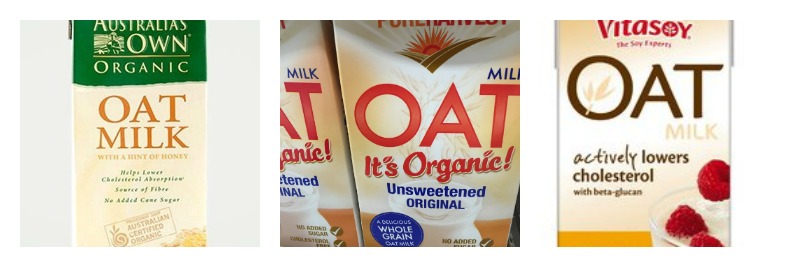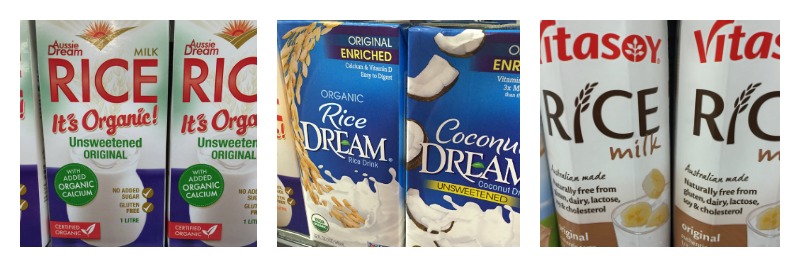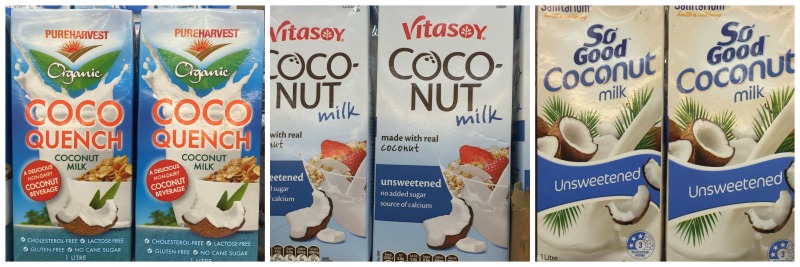Which dairy milk substitute is right for you?

Almond, rice, coconut, soy and oats are all used to make dairy milk substitutes. If you are lactose intolerant, have a milk allergy, or follow a vegan diet then these substitute milks can form an important part of your diet. All are free of lactose, cholesterol and are low in saturated fat but that doesn’t mean they’re perfect. Check out my warning watch points for each of them, especially if you plan to use them regularly, or for adolescents who have high calcium needs.
Note: there is a move to re-name these dairy milk substitutes as "mylks" in order to make the distinction clear that they are NOT mammal-derived liquids, despite the fact that they look and can be used in their place. I support this move.
Soy mylk
Available in full-fat and low-fat versions, soy mylk has a calcium, protein and kilojoule profile that is most like cow’s milk. Soy mylk can be made in two different ways and this may influence your choice at the supermarket:

1. The first way is a milk that is made from whole soy beans that are soaked, heated and then crushed to extract the milky juice which is blended with water, vegetable oil, salt, and sweeteners like malted barley and sugar. Generally, it's low in calcium but rich in protein and B vitamins. This method is regarded as more ‘natural’.
Typical ingredients in whole bean unflavoured soy mylk:
| Filtered water, whole soy beans (17%), pearl barley, barley malt, raw sugar, sunflower oil, natural flavouring, sea salt, kombu (kelp). |
2. The second type is blended from soy protein isolate powder (which is processed from defatted soy flour and contains around 90 per cent pure protein), together with water, oil, sweeteners like sugar or maltodextrin, gums, emulsifier, vitamins, mineral salts and calcium. This is generally fortified with vitamins A, B1, B2, B12 and calcium to a level similar to milk. It has a better flavour with a less ‘beany’ taste. Typical ingredients in protein isolate unflavoured soy mylk:
| Filtered water, soy protein (3.5%), corn maltodextrin, vegetable oils (sunflower, canola), cane sugar, minerals (calcium, phosphorus, magnesium), acidity regulators (332, 450), antioxidant (ascorbic acid), vitamins (A, B12, D2, B2, B1), natural flavour. |
If you have a hormone-sensitive cancer, check with your doctor if it’s ok for you to drink large volumes of soy mylk (say around 1 litre) with its natural plant oestrogens.
Almond mylk
Made from ground almonds, almond mylk is low in carbohydrate, protein and kilojoules. It comes into its own if you’re allergic to both dairy and soy. Plain, unflavoured, almond mylk can be used as a substitute for regular milk in most recipes.
 It has a pleasant nutty flavour that makes a nice milky coffee and teams well in desserts and Middle Eastern recipes. Vanilla flavour and sugar or a sweetener (such as agave) are often added to commercial almond mylks. However, if you have time, you can make your own almond mylk at home by swirling ground almonds with water in a blender then squeezing the liquid out through a fine sieve or mesh. Typical ingredients in unflavoured almond mylk:
It has a pleasant nutty flavour that makes a nice milky coffee and teams well in desserts and Middle Eastern recipes. Vanilla flavour and sugar or a sweetener (such as agave) are often added to commercial almond mylks. However, if you have time, you can make your own almond mylk at home by swirling ground almonds with water in a blender then squeezing the liquid out through a fine sieve or mesh. Typical ingredients in unflavoured almond mylk:
| Filtered water, ground whole almonds (2%), tapioca starch, agave syrup , sunflower oil, salt, carrageenan, lecithin, natural flavour. |
Oat mylk
Popular in Sweden, oat mylk is made from a solution of ground oats swirled with water. It has a naturally light semi-sweet taste (without the need to add sugar or agave syrup), so is a welcome alternative if you dislike the nutty-tasting milks and don’t want added sweeteners. It substitutes well for skim milk.
Oat mylk is high in fibre (particularly beta-glucans) and contains vitamin E, folic acid, minerals and natural phytochemicals. It is not gluten-free. If it’s not fortified, it won’t contain much calcium (you can check the ingredient list to see if a calcium compound is on the list).
 Typical ingredients in unsweetened oat mylk:
Typical ingredients in unsweetened oat mylk:
| Filtered water, whole oats (10-17%), sunflower oil, sea salt. |
Rice mylk
Rice mylk is usually processed from brown rice and is essentially a source of sugary carbohydrate (with around 24 g per glass). The rice mylks that have been tested to date have very high GI values, like their parent rice. Rice mylk is low in nutrient value unless vitamins and calcium are added to it.
 Typical ingredients in unsweetened rice mylk:
Typical ingredients in unsweetened rice mylk:
| Filtered water, whole brown rice (13%), sunflower oil, calcium phosphate, sea salt. |
Coconut mylk
Made by diluting coconut cream with water then adding in sugar or agave, thickeners and a source of calcium. Coconut mylk appeals to the growing vegan sector and allergy market with its claims that it’s dairy-free and soy-free.

Typical ingredients in unflavoured coconut mylk:
| Filtered water, coconut cream, sugar, mineral (calcium phosphate), emulsifier (lecithin), gums (guar, xanthan, carrageenan), natural flavour, salt, modified starch (1450). |
5 handy shopping tips when buying plant milks
I’m still a fan of cow’s milk and am in admiration of the current system for milking, packing and transport in Australia. However, as a descendant of northern European parents and grandparents whose ancestors herded cows for generations and retained the enzyme necessary to digest the lactose, I’m fortunate to be able to consume dairy products without any problems. I’m well aware, though, of those who suffer bloating, diarrhoea or digestive upsets from consuming cow’s milk. So here are my 5 take-home notes.
1. Be prepared to pay.
All these alternative milks cost more than regular cow’s milk. Perhaps that’s because of the smaller scale or the extra processing needed to produce them. Outside of city areas, you’ll mostly find them sold as long-life UHT tetra-pack (not chilled, unlike dairy). So they’re not as ‘natural’ as fresh cow’s milk.
2. Don’t rely on them for calcium.
Nut and grain milks are low in calcium. Definitely not for any calcium-requiring teens in the house. However, you can find many brands that are fortified so that nutritionally they deliver the calcium of cow’s milk. You can check the label for 75 or 120mg calcium per 100mL or look for “calcium phosphate” or “calcium triphosphate” on the ingredient list. See table:
| Plant milk | mg calcium per 100 mL |
| Soy, non-fortified | 8 - 32 |
| Soy, fortified | 120 |
| Almond, non-fortified | 3 |
| Almond, fortified | 75 |
| Oat, fortified | 120 |
| Rice, fortified | 120 |
| Coconut, fortified | 75 |
| Cow's milk, full-cream, for comparison | 120 |
3. They are LOW in protein.
Nut, coconut and oat milk have only around 1 gram protein per 100 mL, which is one-third that of cow’s milk. Rice milk has almost no protein.
4. Soy mylk is the closest to cow’s milk.
In terms of protein, calcium and kilojoules, soy mylks are your best bet and are similar in price.
5. Plant mylks have less saturated fat
Plant mylks are lower in fat and have less saturated fat (dairy is about 2/3 saturated fat).
Bottom line
All of these plant milks are ‘concoctions’ of sorts, being formulated to resemble cow’s milk. If you can tolerate cow’s milk, it’s a healthier option for you and is always cheaper. What’s more, it’s fresher and made from (mostly) a single ingredient.



